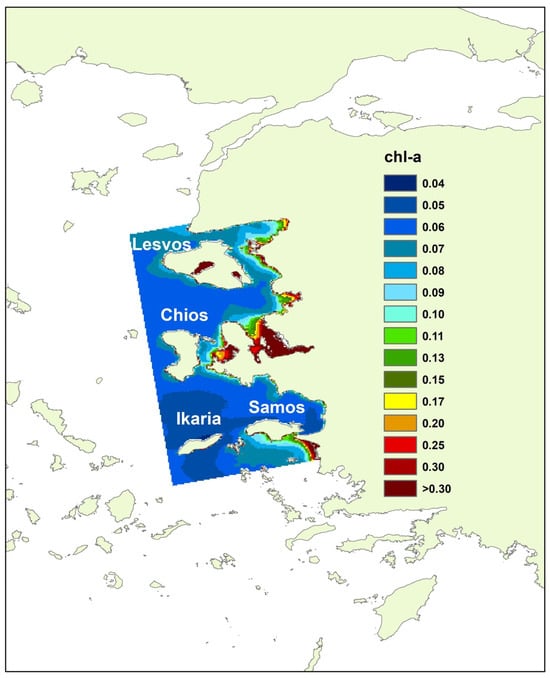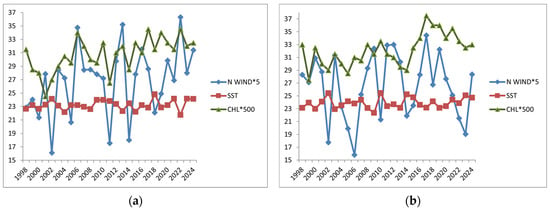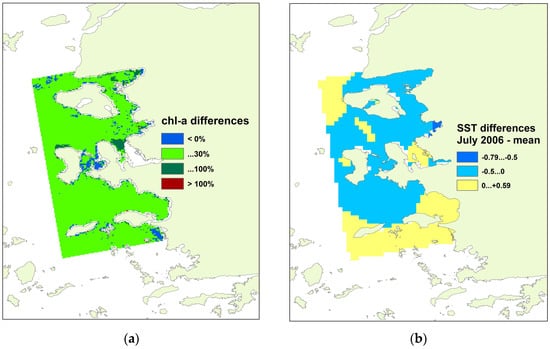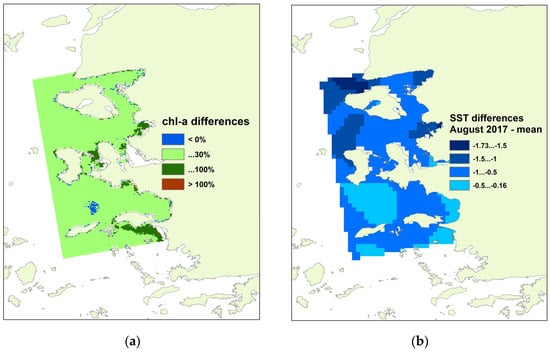Abstract
Etesian winds, the characteristic summer winds over large parts of Greece and the eastern Mediterranean, can cause coastal upwelling, especially over the eastern Aegean. The question that many studies address is whether these northern winds can cause upwelling processes that alter not only sea surface temperature but also chlorophyll concentrations, which are indicative of phytoplankton growth and overall ocean health. The present study is an effort to investigate the above matter over the eastern Aegean, from Lesvos to Ikaria and Samos islands, on a monthly basis, based on all the available satellite chlorophyll data up to now.
1. Introduction
Primary production in the ocean, primarily driven by phytoplankton, forms the foundation of the marine food web, supporting everything from tiny zooplankton to large marine mammals and commercial fish species; in addition, phytoplankton, through photosynthesis, produce much of the Earth’s oxygen. However, phytoplankton growth and distribution are heavily influenced by meteorological conditions and climate change. Factors like ocean temperature, sunlight, and nutrient availability, mainly due to upwelling processes of deeper, colder, and nutrient-rich water, that affect phytoplankton growth are regulated by weather patterns and long-term climate trends. As climate change alters ocean currents, increases stratification, and shifts weather systems, it can disrupt phytoplankton populations—potentially reducing global primary production and affecting carbon cycling and marine food security.
Sea surface chlorophyll levels are key markers of phytoplankton biomass and overall ocean health and are employed for monitoring productivity and detecting shifts in ecosystem dynamics. During recent decades, satellite-measured ocean color properties have revealed information on the oceanographic properties of the sea surface, filling in the gap of the lack of in situ observations and their limited spatiotemporal extent. Chlorophyll-a (chl-a) concentrations, that are derived with the use of relevant algorithms from the satellite-measured reflectance, have also been demonstrated as good indicators for phytoplankton; they are widely used, considering that differences in chlorophyll concentration reflect differences in primary production.
The Hellenic Seas, as part of the oligotrophic Mediterranean Sea, are characterized for the most part by low primary production, following the subtropical model, which is nutrient-limited []. Maximum chlorophyll concentrations are observed in winter or early spring, while in summer, there is a continuous decrease []. Ten years of SeaWiFS chlorophyll data classified the major part of the Hellenic Seas as non-blooming, with chl-a values of >0.3 mg/m3 over the continental coasts and the northern Aegean [], while during summer, sea surface chlorophyll concentrations over most regions rarely reach 0.1 mg/m3 [].
The Etesian winds, the main summer weather feature of the Hellenic Seas, with a maximum strength during July and August around 1200 UTC, are expected to cause upwelling. Such zones of upwelling have been found along the eastern coasts of the Aegean, where the Etesian winds can develop upwelling processes in a time range from a few hours to a few days []. Several studies, for the central and north Aegean, have shown that although coastal upwelling caused by northerlies has a strong impact on sea surface temperature (SST), mainly over their eastern parts, and although an inverse relationship between these parameters has been found and used as a sign of upwelling, no correlation between chl-a concentrations and upwelling has been recorded [,].
The present study examines the possible influence of the Etesian winds on the sea surface chlorophyll concentrations over the eastern Aegean, from Lesvos to Ikaria and Samos islands, considering also SST. It was conducted on a monthly basis (July and August) and is based on all the available satellite chlorophyll data up to now. The importance of the study lies in the potential impact of meteorological wind conditions on sea surface chlorophyll and consequently on phytoplankton levels and marine primary production, also revealing information that can be further used in understanding the influence of climate change on SST and sea surface chlorophyll concentrations.
2. Materials and Methods
The study area refers to the eastern Aegean from Lesvos to Ikaria and Samos islands and is shown in Figure 1, along with the climatological chlorophyll mean map for July and August of the study period, 1998–2024, as calculated from Copernicus Marine Service (CMS) monthly products.

Figure 1.
The study area together with chlorophyll concentration (mg/m3) 1998–2024 climatological mean values for July and August calculated from CMS monthly products.
Chl-a and SST data used are satellite-derived products of CMS, namely the OCEANCOLOUR_MED_BGC_L4_MY_009_144, L4, monthly means for mass concentration of chlorophyll-a in sea water (1 km resolution) and SST_MED_SST_L4_REP_OBSERVATIONS_010_021, L4 daily product for SST (0.05° resolution). The wind data refers to the north component wind speed of each day at 12 UTC and comes from ECMWF ERA5 reanalysis (0.25° resolution).
The study is based on monthly values; hence, monthly mean values were calculated for the SST and north wind component, as well as climatological mean maps of the whole period and all parameters involved.
Pearson correlation coefficients and their statistical significance were calculated between all parameters for July and August separately.
For July 2006 and August 2017, characterized by 30% stronger winds than the climatological mean, the SST and chl-a differences from the respective climatology were calculated to further explore the influence of northerlies on SST and chlorophyll.
3. Results
Mean monthly values of the north wind component, SST and chl-a concentration for July and August of the period 1998–2024 are presented in Figure 2. For July, the Pearson correlation coefficient between northerlies and SST was negative and marginally statistically significant, while the correlation between SST and chl-a was not statistically significant; impressively, northerlies and chl-a were found to be positively and statistically significant correlated. For August, northerlies and SST were statistically significant and negatively correlated, while the correlations between SST/chl-a and northerlies/chl-a were not statistically significant.

Figure 2.
Mean monthly values of north wind component (m/s), SST (°C) and chl-a concentration (mg/m3) for the period 1998–2024: (a) July; (b) August. (The values for wind and chl-a have been multiplied by 5 and 500, respectively, to be better displayed.)
July 2006 and August 2017 were characterized by stronger winds, with northerlies exceeding the mean climatological values by 30%; in addition, chl-a concentrations were also quite high. For these months, chl-a percentage differences and SST differences from the computed climatology were calculated for the whole study area and they are presented in Figure 3 and Figure 4. For chl-a, increases above 30% are presented separately, since this is approximately the accuracy of the ocean color chlorophyll data, and they are considered significant. For July 2006, SST presented small differences from climatology, while for August 2017, quite significant decreases were observed. Nevertheless, for both months, significant chl-a increases exceeding 30% were observed only locally and mainly near the continental coasts.

Figure 3.
Chl-a percentage differences and SST differences from the computed climatology for July 2006: (a) Chl-a differences (%); (b) SST differences (°C).

Figure 4.
Chl-a percentage differences and SST differences from the computed climatology for August 2017: (a) Chl-a differences (%); (b) SST differences (°C).
4. Discussion and Conclusions
Northerlies and SST were found to be negatively and statistically significant correlated, which is a sign of upwelling taking place over the study area; this is in agreement with other studies that observed such correlations for parts of the study area or revealed that summer SST patterns present strong cooling and large negative anomalies associated with upwelling due to strong northerlies [,].
No statistically significant correlation was found between northerlies and chlorophyll concentrations for August, while for July, the parameters were positively correlated. However, the study of the windiest July (2006) and August (2017) revealed chlorophyll increases that do not exceed 30% compared to climatology and they cannot be considered significant. Chlorophyll variations presented an increase of >30% locally near the continental coasts, where eutrophication phenomena under the pressure of high anthropogenic nutrient loads can be observed. In previous studies for the eastern Aegean, enhanced northerlies and lower SSTs were not found together with sea surface chlorophyll increases []; in addition, an extensive study focused on specific upwelling events found low chl-a concentrations and concluded that no significant bloom can occur due to the small upwelling depth [].
SST and chl-a were not statistically significant correlated, indicating that the upwelling process, which lowers SST, can hardly be favorable for sea surface chlorophyll increases. It should be noted that during summer, the region’s mixed layer depth is estimated not to exceed 30 m [] and is nutrient poor; the deep chlorophyll maximum lies at a depth of about 80 m, and upwelling events seem not to be capable of transferring nutrients to the surface, unless a very deep and persistent upwelling occurs [].
Conclusion of the present work: The correlation between northerlies and SST was found to be negative and statistically significant, especially for August; SST and chlorophyll concentrations were not significantly correlated. Although a positive correlation was found between the north wind component and chlorophyll concentrations for July, chlorophyll increases with respect to the mean climatological values of the whole period can be hardly considered significant, even during months characterized by enhanced winds.
Funding
This research received no external funding.
Institutional Review Board Statement
Not applicable.
Informed Consent Statement
Not applicable.
Data Availability Statement
No new data were created or analyzed in this study. Data sharing is not applicable to this article.
Acknowledgments
ECMWF and Copernicus Marine Service are acknowledged for the data.
Conflicts of Interest
The author declares no conflicts of interest.
References
- Karydis, M.; Kitsiou, D. Eutrophication and environmental policy in the Mediterranean Sea: A review. Environ. Monit. Assess. 2012, 184, 4931–4984. [Google Scholar] [CrossRef] [PubMed]
- D’Ortenzio, F.; Ribera d’Alcalà, M. On the trophic regimes of the Mediterranean Sea: A satellite analysis. Biogeosciences 2009, 6, 139–148. [Google Scholar] [CrossRef]
- Skliris, N.; Mantziafou, A.; Sofianos, S.; Gkanasos, A. Satellite-derived variability of the Aegean Sea ecohydrodynamics. Cont. Shelf Res. 2010, 30, 403–418. [Google Scholar] [CrossRef]
- Androulidakis, Y.; Krestenitis, Y.; Kourafalou, V. Etesian Winds and Coastal Upwelling over the NE Aegean Sea: Monitoring and modeling. In Proceedings of the 2015 ASLO Aquatic Sciences Meeting, Granada, Spain, 22–27 February 2015. [Google Scholar]
- Androulidakis, Y.S.; Krestenitis, Y.N.; Psarra, S. Coastal upwelling over the North Aegean Sea: Observations and simulations. Cont. Shelf Res. 2017, 149, 32–51. [Google Scholar] [CrossRef]
- D’Ortenzio, F.; Iudicone, D.; Montegut, C.D.; Testor, P.; Antoine, D.; Marullo, S.; Santoleri, R.; Madec, G. Seasonal variability of the mixed layer depth in the Mediterranean Sea as derived from in situ profiles. Geophys. Res. Lett. 2005, 32, L12605. [Google Scholar] [CrossRef]
Disclaimer/Publisher’s Note: The statements, opinions and data contained in all publications are solely those of the individual author(s) and contributor(s) and not of MDPI and/or the editor(s). MDPI and/or the editor(s) disclaim responsibility for any injury to people or property resulting from any ideas, methods, instructions or products referred to in the content. |
© 2025 by the author. Licensee MDPI, Basel, Switzerland. This article is an open access article distributed under the terms and conditions of the Creative Commons Attribution (CC BY) license (https://creativecommons.org/licenses/by/4.0/).